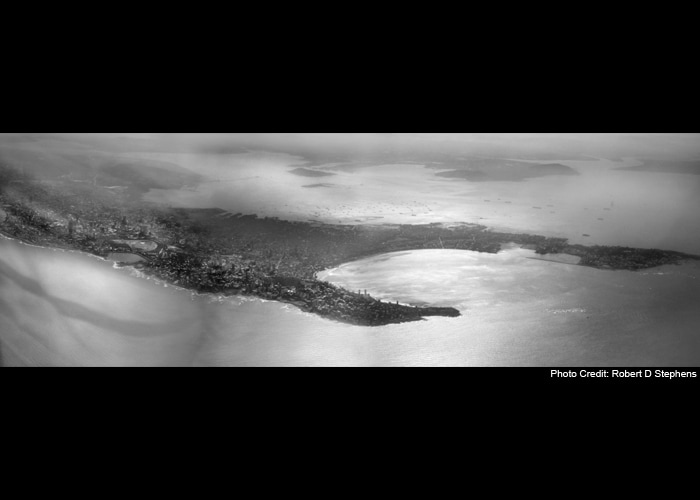Mumbai From the Sky
Maximum City photographed from 15,000 feet above
-
 Robert D Stephens flew 15,000ft above the city to take photographs for his Mumbai Articles exhibition, which will run at Artisans in the Kala Ghoda art district until 19 November.Bombay Island CityMumbai, formerly known as Bombay, is India's financial capital and home to more than 18 million people. The surrounding waterways fuelled its economic growth as a globally connected port city, but they also constrain a continually growing population into smaller living quarters within finite geographic boundaries.This photo-gallery was first published on The Guardian
Robert D Stephens flew 15,000ft above the city to take photographs for his Mumbai Articles exhibition, which will run at Artisans in the Kala Ghoda art district until 19 November.Bombay Island CityMumbai, formerly known as Bombay, is India's financial capital and home to more than 18 million people. The surrounding waterways fuelled its economic growth as a globally connected port city, but they also constrain a continually growing population into smaller living quarters within finite geographic boundaries.This photo-gallery was first published on The Guardian -
 Tardeo to DadarThe Mahalaxmi Racecourse in south Mumbai (on the left) is one of the few consolidated green spaces in the city. In 1841 the British procured land here without compensating the original inhabitants. Today, the land is exceptionally valuable. The apartments seen here sell for 30,000-48,000 rupees/sq ft (£300-500/sq ft).This photo-gallery was first published on The Guardian
Tardeo to DadarThe Mahalaxmi Racecourse in south Mumbai (on the left) is one of the few consolidated green spaces in the city. In 1841 the British procured land here without compensating the original inhabitants. Today, the land is exceptionally valuable. The apartments seen here sell for 30,000-48,000 rupees/sq ft (£300-500/sq ft).This photo-gallery was first published on The Guardian -
 Mumbai MistA reminder that even amid pollution and overcrowding, redemptive beauty can take place.This photo-gallery was first published on The Guardian
Mumbai MistA reminder that even amid pollution and overcrowding, redemptive beauty can take place.This photo-gallery was first published on The Guardian -
 Capital MissilesThe Lower Parel region of south Mumbai used to be identified by a multitude of smoke stacks from the cotton mills, but they have shut down and the land was sold to developers. The result has been careless and unplanned growth, without holistic, civic, or environmental concern. Up to half of the apartments seen here remain empty.This photo-gallery was first published on The Guardian
Capital MissilesThe Lower Parel region of south Mumbai used to be identified by a multitude of smoke stacks from the cotton mills, but they have shut down and the land was sold to developers. The result has been careless and unplanned growth, without holistic, civic, or environmental concern. Up to half of the apartments seen here remain empty.This photo-gallery was first published on The Guardian -
 Monsoon SunriseThe arrival of Monsoon season is always welcome in Mumbai. If you ask any taxi driver when it will begin, the answer is always 10 June, but the start and end dates are becoming less predictable. Mumbaikars love the first rains, because they purify the air, washing away the pollution that had been pestering the inhabitants.This photo-gallery was first published on The Guardian
Monsoon SunriseThe arrival of Monsoon season is always welcome in Mumbai. If you ask any taxi driver when it will begin, the answer is always 10 June, but the start and end dates are becoming less predictable. Mumbaikars love the first rains, because they purify the air, washing away the pollution that had been pestering the inhabitants.This photo-gallery was first published on The Guardian -
 Urban KabirThe Bandra-Worli sea link is one of Mumbai's newest and most photogenic landmarks, poetically weaving its way in and out of the city landmass like an urban manifestation of the Indian poet saint Kabir. It's been built in the Arabian Sea to provide an expedient and direct link between the northern and southern parts of the city.This photo-gallery was first published on The Guardian
Urban KabirThe Bandra-Worli sea link is one of Mumbai's newest and most photogenic landmarks, poetically weaving its way in and out of the city landmass like an urban manifestation of the Indian poet saint Kabir. It's been built in the Arabian Sea to provide an expedient and direct link between the northern and southern parts of the city.This photo-gallery was first published on The Guardian -
 Ocean to HarbourWith an average width of three miles, Mumbai is one of the thinnest megacities in the world. This has led to linear urban growth with the business districts in the south and residential areas in the north. Continually escalating land prices have pushed the middle and lower classes northwards, increasing commuting times dramatically.This photo-gallery was first published on The Guardian
Ocean to HarbourWith an average width of three miles, Mumbai is one of the thinnest megacities in the world. This has led to linear urban growth with the business districts in the south and residential areas in the north. Continually escalating land prices have pushed the middle and lower classes northwards, increasing commuting times dramatically.This photo-gallery was first published on The Guardian -
 Twins and AntiliaThe twin skyscrapers (left of centre) known as the Imperial Towers and Mukesh Ambani's skyscraper home Antilia (on the right) cast shadows on Haji Ali, an island dargah (Islamic shrine). In the background, the smooth arc of the Queen's Necklace gives formal and graphic definition to one of the only public spaces in south Mumbai.Photograph: Robert D StephensThis photo-gallery was first published on The Guardian
Twins and AntiliaThe twin skyscrapers (left of centre) known as the Imperial Towers and Mukesh Ambani's skyscraper home Antilia (on the right) cast shadows on Haji Ali, an island dargah (Islamic shrine). In the background, the smooth arc of the Queen's Necklace gives formal and graphic definition to one of the only public spaces in south Mumbai.Photograph: Robert D StephensThis photo-gallery was first published on The Guardian
Advertisement
Advertisement
Advertisement
